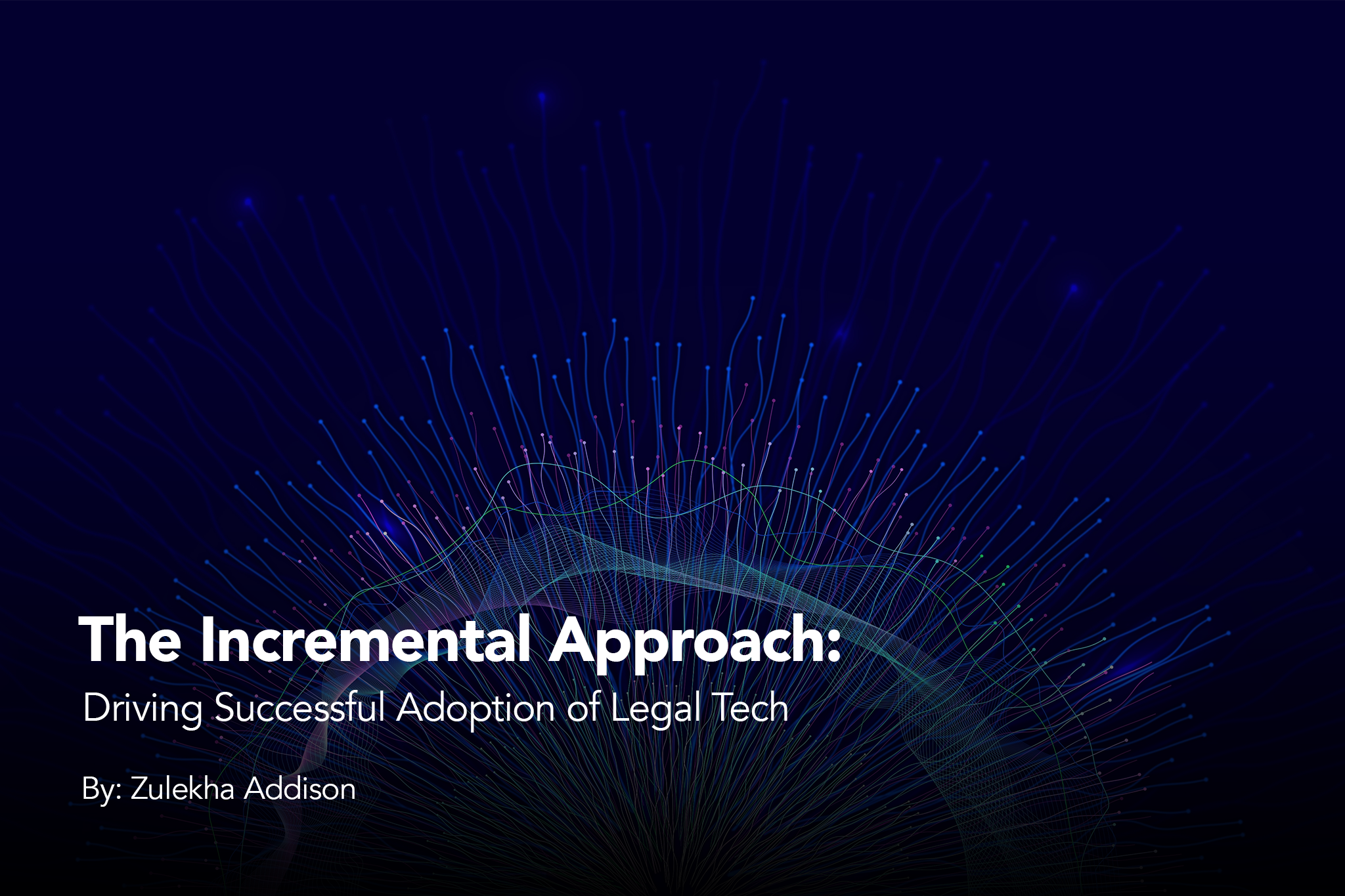 Imagine this: You’ve invested significantly in the latest legal tech promising to transform your legal department’s operations. But weeks, then months, pass and the fancy, new software is barely used. Sound familiar? This scenario underscores a vital point often overlooked in the race to stay ahead of technology: human adaptation doesn’t keep pace with technological evolution.
Imagine this: You’ve invested significantly in the latest legal tech promising to transform your legal department’s operations. But weeks, then months, pass and the fancy, new software is barely used. Sound familiar? This scenario underscores a vital point often overlooked in the race to stay ahead of technology: human adaptation doesn’t keep pace with technological evolution.
The Power of Incremental Change
The rallying cry across Silicon Valley is: move fast and break things. But things necessarily move slower in other parts of corporate America, including in the legal industry, because while software may scale, people don’t. That’s why change within most organizations happens incrementally.
The value of an incremental approach to institutional change is not new. Consider the evolution of the assembly line, one of the most transformative innovations in the industrial era. When Henry Ford introduced this concept, he didn’t overhaul the entire production process in one fell swoop. Instead, the change was incremental.
Initial adjustments included simple rearrangements of workstations for efficiency. Over time, as workers adapted to these changes, Ford introduced conveyor belts to automate certain aspects. This progressive implementation facilitated workers’ adaptation to new work methods and paved the way for the full-fledged assembly line system we recognize today.
More than 100 years later, it’s more of the same. No matter how promising a technological advancement or streamlined process may be, without a focus on adoption and implementation within an organization, the potential gains will go unrealized. That’s why the incremental approach to change is so important.
Strategies for Effective Adoption and Implementation
Steering through the journey of change can be daunting. However, certain strategies and practical steps can simplify the process, driving incremental adoption within your organization.
Simplicity and User-Friendliness
The easier a technology is to use, the higher its adoption rate. This not only involves selecting intuitive tools but also simplifying procedures around the tech. For instance, instead of implementing a full suite of features all at once, consider introducing key features first and gradually rolling out additional capabilities.
Practical Steps: Consider the user experience when choosing a platform. Does it have an intuitive interface? Can it be easily integrated with existing systems? Does it mimic familiar patterns? When rolling out the new technology, introduce one feature or function at a time, allowing users to familiarize themselves with each aspect of the platform before introducing the next. This gradual learning process can reduce overwhelm and increase the chances of successful adoption.
Getting Your Data in Order
Artificial intelligence-powered legal tech has tremendous potential to help businesses sort through, analyze, and optimize massive amounts of data. However, for the software to do its job, it must be able to access the data it needs. Layering software on top of a disorganized system won’t solve the problem.
Practical Steps: Rather than spending time and resources trying to integrate software to manage “dirty” data, a better investment would be to clean up existing data and implement more organized systems for data capture moving forward. Once those systems are in place, legal tech can then be deployed to extract and analyze data, and create efficiencies in the review, negotiation, and management processes.
 Creating Awareness and Educating Users
Creating Awareness and Educating Users
Change requires buy-in from all stakeholders, and this starts with creating awareness about the need for the tech and educating users on its benefits.
Practical Steps: Consider setting up regular meetings to discuss upcoming changes and conduct workshops for hands-on experience with the new tech. Provide clear, concise, and easily accessible learning materials such as user guides, video tutorials, and FAQs. Working with legal tech providers to offer a “sandbox” environment where users can explore and practice with the new tech without affecting live data can also be helpful.
Personalizing Benefits and Demonstrating Real-World Impact
While showing the overall benefits of a tech solution is necessary, illustrating the direct benefits to individual users is equally important. To drive adoption, it’s critical to help your people understand how new tools will help them make their jobs and lives easier.
Practical Steps: Tailor the training and communication to address the specific challenges and goals of different teams or roles. Highlight case studies or success stories from within the organization to reinforce the practical value of the tech. For example, if you’re implementing an AI-based contract analysis tool, demonstrate how it can significantly reduce the time spent on contract review, allowing legal professionals to focus more on strategic tasks.
Integrating Tech into Existing Workflows
Integrating new tech into existing workflows can promote its usage. Rather than expecting employees to drastically alter their work patterns, find ways to incorporate the tech into their current routines.
Practical Steps: This could mean integrating a new contract management system with the existing CRM or embedding legal research software into the company’s intranet. Work closely with teams to understand their current processes and identify opportunities where the new technology could be seamlessly integrated.
Fostering a Culture of Innovation
Creating a culture that embraces innovation can significantly improve tech adoption.
Practical Steps: Encourage employees to experiment with new solutions and provide feedback. Set up a suggestion box or a digital platform where employees can share their experiences, ideas, and challenges related to the new tech. Recognize and reward those who make effective use of new technology. This not only motivates the rewarded individuals but also inspires others to explore and embrace new technology.
How can Lexitas’ Legal Tech Help You
Record Insights: An AI-Enabled Chronological Summary of Medical Records
For cases involving hundreds or thousands of medical records, manually reviewing documents is inefficient, inconsistent, labor intensive, and time consuming.
Lexitas’ Record Insights™ extracts medical information and creates a user-friendly report summarizing the medical records. The complete medical history is summarized within a few pages with information displayed chronologically, allowing the user to search and filter the information by medical condition, date, body system, and more.
How it Works
Medical records often contain unstructured data, such as images or handwritten documents. Record Insights™ uses natural language processing (NLP) to analyze medical documents and extracts relevant information in a user-friendly report. Users are presented with a case overview of key impairments and recent findings and can view relevant information with an easy-to-use navigation system.
Benefits
Save time and money, when requested as part of your records request, Record Insights report will be delivered along with your records
Increase productivity; we retrieve your records and provide you with a full medical chronology
Gain immediate access to the key points of your case to resolve quicker
Our records team will walk you through a personalized demo and your dedicated Account Manager will assist in adding Record Insights to your orders
Organizational change, especially related to the adoption of new technology, presents both opportunities and challenges. Given the human pace of adaptation, an incremental approach is key to navigating this terrain successfully. Gradual implementation allows individuals and organizations
to adapt more effectively, optimizing the benefits of new technologies.
To drive successful implementation, focus on user-friendly solutions, create awareness, educate users, and demonstrate the practical impact of the tech solution. Personalize the benefits and integrate new technology into existing workflows. By fostering a culture that encourages innovation, you can facilitate the adoption of new tech and make the most of the opportunities it presents.
Lexitas is dedicated to ensuring the highest quality of legal technology and the highest security and privacy of your sensitive records data.
The digital revolution in the legal industry, as in any other, requires more than just the latest tech. It requires a thoughtful, human-centric approach. It’s not just about staying current; it’s about moving forward, one step at a time.
If you would like to learn how Lexitas can help you get things organized and ready to take the next step, visit lexitaslegal.com

Leave a Comment